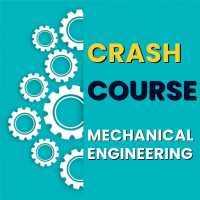Mechanical Engineering Exam > Mechanical Engineering Questions > Can you explain the answer of this question b...
Start Learning for Free
Can you explain the answer of this question below:
Let X and Y be two independent random variables. Which one of the relations between expectation (E), variance (Var) and covariance (Cov) given below is FALSE?
- A:E (XY) = E (X) E (Y)
- B:Cov (X, Y) = 0
- C:Var (X + Y) = Var (X) + Var (Y)
- D:E (X2 y2) = (E (X))2 (E (y))2
The answer is b.
Most Upvoted Answer
Can you explain the answer of this question below:Let X and Y be two i...
Chebyshev is a mathematical term that refers to the Chebyshev inequality or the Chebyshev's theorem. It is a statistical concept that provides an upper bound for the probability of a random variable deviating from its mean by more than a certain number of standard deviations.
The Chebyshev's inequality states that for any random variable with a finite mean and variance, the probability that the random variable deviates from its mean by more than k standard deviations is less than or equal to 1/k^2, where k is any positive number greater than 1.
In other words, Chebyshev's inequality provides a general bound on the probability of extreme events occurring, regardless of the shape of the probability distribution. It is widely used in probability theory and statistics to estimate the likelihood of rare events or outliers.
The Chebyshev inequality is a useful tool in statistical analysis and can be applied to various fields including finance, physics, and engineering. It allows for the estimation of probabilities without assuming any specific distribution, which makes it a versatile and practical tool in many applications.
The Chebyshev's inequality states that for any random variable with a finite mean and variance, the probability that the random variable deviates from its mean by more than k standard deviations is less than or equal to 1/k^2, where k is any positive number greater than 1.
In other words, Chebyshev's inequality provides a general bound on the probability of extreme events occurring, regardless of the shape of the probability distribution. It is widely used in probability theory and statistics to estimate the likelihood of rare events or outliers.
The Chebyshev inequality is a useful tool in statistical analysis and can be applied to various fields including finance, physics, and engineering. It allows for the estimation of probabilities without assuming any specific distribution, which makes it a versatile and practical tool in many applications.
Free Test
FREE
| Start Free Test |
Community Answer
Can you explain the answer of this question below:Let X and Y be two i...
If a bell curve is assumed, the probability of a “six sigma” event is on the order of one ten millionth of a percent.

|
Explore Courses for Mechanical Engineering exam
|

|
Question Description
Can you explain the answer of this question below:Let X and Y be two independent random variables. Which one of the relations between expectation (E), variance (Var) and covariance (Cov) given below is FALSE?A:E (XY) = E (X) E (Y) B:Cov (X, Y) = 0C:Var (X + Y) = Var (X) + Var (Y)D:E (X2 y2) = (E (X))2 (E (y))2The answer is b. for Mechanical Engineering 2025 is part of Mechanical Engineering preparation. The Question and answers have been prepared according to the Mechanical Engineering exam syllabus. Information about Can you explain the answer of this question below:Let X and Y be two independent random variables. Which one of the relations between expectation (E), variance (Var) and covariance (Cov) given below is FALSE?A:E (XY) = E (X) E (Y) B:Cov (X, Y) = 0C:Var (X + Y) = Var (X) + Var (Y)D:E (X2 y2) = (E (X))2 (E (y))2The answer is b. covers all topics & solutions for Mechanical Engineering 2025 Exam. Find important definitions, questions, meanings, examples, exercises and tests below for Can you explain the answer of this question below:Let X and Y be two independent random variables. Which one of the relations between expectation (E), variance (Var) and covariance (Cov) given below is FALSE?A:E (XY) = E (X) E (Y) B:Cov (X, Y) = 0C:Var (X + Y) = Var (X) + Var (Y)D:E (X2 y2) = (E (X))2 (E (y))2The answer is b..
Can you explain the answer of this question below:Let X and Y be two independent random variables. Which one of the relations between expectation (E), variance (Var) and covariance (Cov) given below is FALSE?A:E (XY) = E (X) E (Y) B:Cov (X, Y) = 0C:Var (X + Y) = Var (X) + Var (Y)D:E (X2 y2) = (E (X))2 (E (y))2The answer is b. for Mechanical Engineering 2025 is part of Mechanical Engineering preparation. The Question and answers have been prepared according to the Mechanical Engineering exam syllabus. Information about Can you explain the answer of this question below:Let X and Y be two independent random variables. Which one of the relations between expectation (E), variance (Var) and covariance (Cov) given below is FALSE?A:E (XY) = E (X) E (Y) B:Cov (X, Y) = 0C:Var (X + Y) = Var (X) + Var (Y)D:E (X2 y2) = (E (X))2 (E (y))2The answer is b. covers all topics & solutions for Mechanical Engineering 2025 Exam. Find important definitions, questions, meanings, examples, exercises and tests below for Can you explain the answer of this question below:Let X and Y be two independent random variables. Which one of the relations between expectation (E), variance (Var) and covariance (Cov) given below is FALSE?A:E (XY) = E (X) E (Y) B:Cov (X, Y) = 0C:Var (X + Y) = Var (X) + Var (Y)D:E (X2 y2) = (E (X))2 (E (y))2The answer is b..
Solutions for Can you explain the answer of this question below:Let X and Y be two independent random variables. Which one of the relations between expectation (E), variance (Var) and covariance (Cov) given below is FALSE?A:E (XY) = E (X) E (Y) B:Cov (X, Y) = 0C:Var (X + Y) = Var (X) + Var (Y)D:E (X2 y2) = (E (X))2 (E (y))2The answer is b. in English & in Hindi are available as part of our courses for Mechanical Engineering.
Download more important topics, notes, lectures and mock test series for Mechanical Engineering Exam by signing up for free.
Here you can find the meaning of Can you explain the answer of this question below:Let X and Y be two independent random variables. Which one of the relations between expectation (E), variance (Var) and covariance (Cov) given below is FALSE?A:E (XY) = E (X) E (Y) B:Cov (X, Y) = 0C:Var (X + Y) = Var (X) + Var (Y)D:E (X2 y2) = (E (X))2 (E (y))2The answer is b. defined & explained in the simplest way possible. Besides giving the explanation of
Can you explain the answer of this question below:Let X and Y be two independent random variables. Which one of the relations between expectation (E), variance (Var) and covariance (Cov) given below is FALSE?A:E (XY) = E (X) E (Y) B:Cov (X, Y) = 0C:Var (X + Y) = Var (X) + Var (Y)D:E (X2 y2) = (E (X))2 (E (y))2The answer is b., a detailed solution for Can you explain the answer of this question below:Let X and Y be two independent random variables. Which one of the relations between expectation (E), variance (Var) and covariance (Cov) given below is FALSE?A:E (XY) = E (X) E (Y) B:Cov (X, Y) = 0C:Var (X + Y) = Var (X) + Var (Y)D:E (X2 y2) = (E (X))2 (E (y))2The answer is b. has been provided alongside types of Can you explain the answer of this question below:Let X and Y be two independent random variables. Which one of the relations between expectation (E), variance (Var) and covariance (Cov) given below is FALSE?A:E (XY) = E (X) E (Y) B:Cov (X, Y) = 0C:Var (X + Y) = Var (X) + Var (Y)D:E (X2 y2) = (E (X))2 (E (y))2The answer is b. theory, EduRev gives you an
ample number of questions to practice Can you explain the answer of this question below:Let X and Y be two independent random variables. Which one of the relations between expectation (E), variance (Var) and covariance (Cov) given below is FALSE?A:E (XY) = E (X) E (Y) B:Cov (X, Y) = 0C:Var (X + Y) = Var (X) + Var (Y)D:E (X2 y2) = (E (X))2 (E (y))2The answer is b. tests, examples and also practice Mechanical Engineering tests.

|
Explore Courses for Mechanical Engineering exam
|

|
Signup for Free!
Signup to see your scores go up within 7 days! Learn & Practice with 1000+ FREE Notes, Videos & Tests.


















